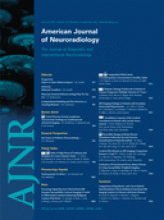Research ArticleNeurointervention
Endovascular Treatment for Unruptured Intracranial Aneurysms in Elderly Patients: Single-Center Report
S.-K. Hwang, G. Hwang, C.W. Oh, S.-C. Jin, H. Park, J.S. Bang and O.-K. Kwon
American Journal of Neuroradiology June 2011, 32 (6) 1087-1090; DOI: https://doi.org/10.3174/ajnr.A2458
S.-K. Hwang
G. Hwang
C.W. Oh
S.-C. Jin
H. Park
J.S. Bang

References
- 1.↵
- Chung RY,
- Carter BS,
- Norbash A,
- et al
- 2.↵
- Fridriksson SM,
- Hillman J,
- Saveland H,
- et al
- 3.↵
- 4.↵
- Inagawa T,
- Yamamoto M,
- Kamiya K,
- et al
- 5.↵
- Iwamoto H,
- Kiyohara Y,
- Fujishima M,
- et al
- 6.↵
- 7.↵
- 8.↵
- Lanzino G
- 9.↵
- O'Sullivan MG,
- Dorward N,
- Whittle IR,
- et al
- 10.↵
- Rosenørn J,
- Eskesen V,
- Schmidt K
- 11.↵
- Ryttlefors M,
- Enblad P,
- Kerr RS,
- et al
- 12.↵
- Sarti C,
- Tuomilehto J,
- Salomaa V,
- et al
- 13.↵
- Yamashita K,
- Kashiwagi S,
- Kato S,
- et al
- 14.↵
- Guglielmi G,
- Vinuela F,
- Dion J,
- et al
- 15.↵
- Johansson M,
- Cesarini KG,
- Contant CF,
- et al
- 16.↵
- Lubicz B,
- Leclerc X,
- Gauvrit JY,
- et al
- 17.↵
- Sawada M,
- Kaku Y,
- Hayashi K,
- et al
- 18.↵
- Weir R,
- Marcellus M,
- Do H,
- et al
- 19.↵
- Bracard S
- 20.↵
- Brilstra EH,
- Rinkel GJ,
- van der Graaf Y,
- et al
- 21.↵
- 22.↵
- Molyneux AJ,
- Kerr RS,
- Yu LM,
- et al.,
- for the International Subarachnoid Aneurysm Trial (ISAT) Collaborative Group
- 23.↵
- 24.↵
- Raftopoulos C,
- Mathurin P,
- Boscherini D,
- et al
- 25.↵
- Sedat J,
- Dib M,
- Lonjon M,
- et al
- 26.↵
- Barker FG 2nd.,
- Amin-Hanjani S,
- Butler WE,
- et al
- 27.↵
- Juvela S,
- Porras M,
- Poussa K
- 28.↵
- Juvela S,
- Porras M,
- Heiskanen O
- 29.↵
- Weir B
- 30.↵
- Wiebers DO,
- Whisnant JP,
- Huston J 3rd.,
- et al.,
- for the International Study of Unruptured Intracranial Aneurysms Investigators
- 31.↵
- de Rooij NK,
- Linn FH,
- van der Plas JA,
- et al
- 32.↵
- Inagawa T
- 33.↵
- Stachniak J,
- Layon A,
- Day A,
- et al
- 34.↵
- Higashida RT,
- Lahue BJ,
- Torbey MT,
- et al
- 35.↵
- Cai Y,
- Spelle L,
- Wang H,
- et al
- 36.↵
In this issue
Advertisement
S.-K. Hwang, G. Hwang, C.W. Oh, S.-C. Jin, H. Park, J.S. Bang, O.-K. Kwon
Endovascular Treatment for Unruptured Intracranial Aneurysms in Elderly Patients: Single-Center Report
American Journal of Neuroradiology Jun 2011, 32 (6) 1087-1090; DOI: 10.3174/ajnr.A2458
0 Responses
Jump to section
Related Articles
- No related articles found.
Cited By...
- Elderly patients with intracranial aneurysms have higher quality of life after coil embolization: a decision analysis
- Treatment results of endosaccular coil embolization of asymptomatic unruptured intracranial aneurysms in elderly patients
- Endovascular Treatment of Intracranial Aneurysms in Elderly Patients: A Systematic Review and Meta-Analysis
This article has been cited by the following articles in journals that are participating in Crossref Cited-by Linking.
- Annemijn M. Algra, Antti Lindgren, Mervyn D. I. Vergouwen, Jacoba P. Greving, Irene C. van der Schaaf, Tristan P. C. van Doormaal, Gabriel J. E. RinkelJAMA Neurology 2019 76 3
- Carmelo L. Sturiale, Waleed Brinjikji, Mohammad H. Murad, Giuseppe LanzinoStroke 2013 44 7
- Kelly B. Mahaney, Robert D. Brown, Irene Meissner, David G. Piepgras, John Huston, Jie Zhang, James C. TornerJournal of Neurosurgery 2014 121 5
- Nicholas Caffes, Nicole Wenger, Gregory Cannarsa, Jeffrey Oliver, Chimdiya Onwukwe, Dheeraj Gandhi, J. Marc SimardAnnals of Medicine 2021 53 1
- Michelle J Smith, Matthew R Sanborn, Daniel J Lewis, Ryan W F Faught, Venus Vakhshori, Sherman C SteinJournal of NeuroInterventional Surgery 2015 7 12
- Hidenori Oishi, Munetaka Yamamoto, Senshu Nonaka, Takashi Shimizu, Kensaku Yoshida, Takashi Mitsuhashi, Hajime AraiJournal of NeuroInterventional Surgery 2015 7 9
- Sarah H. Eisen, Bradley J. Hindman, Emine O. Bayman, Franklin Dexter, David M. HasanAnesthesia & Analgesia 2015 121 1
- Joji Inamasu, Teppei Tanaka, Akiyo Sadato, Motoharu Hayakawa, Kazuhide Adachi, Takuro Hayashi, Yoko Kato, Yuichi HiroseGeriatrics & Gerontology International 2014 14 4
- Caleb Rutledge, Daniel M.S. Raper, Soren Jonzzon, Kunal P. Raygor, Matheus Prado Pereira, Ethan A. Winkler, Li Zhang, Michael T. Lawton, Adib A. AblaWorld Neurosurgery 2021 152
- Samuel D. Pettersson, MirHojjat Khorasanizadeh, Benton Maglinger, Alfonso Garcia, S. Jennifer Wang, Philipp Taussky, Christopher S. OgilvyWorld Neurosurgery 2023 178
More in this TOC Section
Similar Articles
Advertisement











